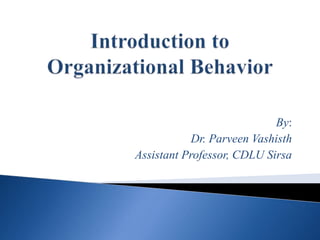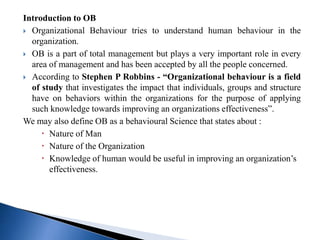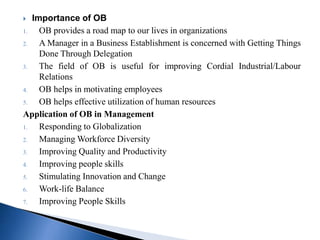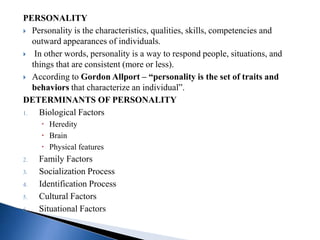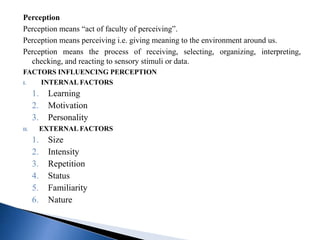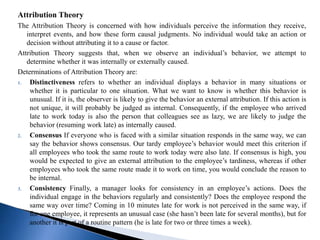Introduction to Organizational Behavior.pptx
- 1. By: Dr. Parveen Vashisth Assistant Professor, CDLU Sirsa
- 2. Introduction to OB ’üĮ Organizational Behaviour tries to understand human behaviour in the organization. ’üĮ OB is a part of total management but plays a very important role in every area of management and has been accepted by all the people concerned. ’üĮ According to Stephen P Robbins - ŌĆ£Organizational behaviour is a field of study that investigates the impact that individuals, groups and structure have on behaviors within the organizations for the purpose of applying such knowledge towards improving an organizations effectivenessŌĆØ. We may also define OB as a behavioural Science that states about : ’é¢ Nature of Man ’é¢ Nature of the Organization ’é¢ Knowledge of human would be useful in improving an organizationŌĆÖs effectiveness.
- 3. ’üĮ Importance of OB 1. OB provides a road map to our lives in organizations 2. A Manager in a Business Establishment is concerned with Getting Things Done Through Delegation 3. The field of OB is useful for improving Cordial Industrial/Labour Relations 4. OB helps in motivating employees 5. OB helps effective utilization of human resources Application of OB in Management 1. Responding to Globalization 2. Managing Workforce Diversity 3. Improving Quality and Productivity 4. Improving people skills 5. Stimulating Innovation and Change 6. Work-life Balance 7. Improving People Skills
- 4. Shortcomings of OB 1. Failure of Individual on the Domestic Front 2. Failure to contribute to improve Interpersonal Relations 3. OB is selfish and exploitative 4. Expectation of quick fix solutions 5. OB will not totally abolish conflict and frustration, it can only reduce them. Organizational culture refers to the shared behavioral expectations and norms in a work environment. This is the collective view of ŌĆ£the way work is done.ŌĆØ Organizational climate represents staff perceptions of the impact of the work environment on the individual. This is the view of ŌĆ£how it feelsŌĆØ to work at the agency (e.g., supportive, stressful). An Organizational culture and climate influence how child welfare staff at all levels do their work and how they feel about their work. Staff with the right skills and knowledge may not achieve an Organizational objectives if the culture discourages their appropriate use. For example, caseworkers may receive training on family engagement skills, but they may not apply those skills unless the agency culture also supports and rewards working in partnership with parents in meaningful ways. Further, if the agency climate causes staff to feel overwhelmed and unmotivated, they may not be ready for new initiatives and may resist changing responsibilities. Finally, organizational culture and climate can influence staff morale. Low morale can result in staff turnover, which in turn, can have a negative impact on agency functioning and service delivery to children and families.
- 5. PERSONALITY ’üĮ Personality is the characteristics, qualities, skills, competencies and outward appearances of individuals. ’üĮ In other words, personality is a way to respond people, situations, and things that are consistent (more or less). ’üĮ According to Gordon Allport ŌĆō ŌĆ£personality is the set of traits and behaviors that characterize an individualŌĆØ. DETERMINANTS OF PERSONALITY 1. Biological Factors ’é¢ Heredity ’é¢ Brain ’é¢ Physical features 2. Family Factors 3. Socialization Process 4. Identification Process 5. Cultural Factors 6. Situational Factors
- 6. Perception Perception means ŌĆ£act of faculty of perceivingŌĆØ. Perception means perceiving i.e. giving meaning to the environment around us. Perception means the process of receiving, selecting, organizing, interpreting, checking, and reacting to sensory stimuli or data. FACTORS INFLUENCING PERCEPTION I. INTERNAL FACTORS 1. Learning 2. Motivation 3. Personality II. EXTERNAL FACTORS 1. Size 2. Intensity 3. Repetition 4. Status 5. Familiarity 6. Nature
- 7. Attribution Theory The Attribution Theory is concerned with how individuals perceive the information they receive, interpret events, and how these form causal judgments. No individual would take an action or decision without attributing it to a cause or factor. Attribution Theory suggests that, when we observe an individualŌĆÖs behavior, we attempt to determine whether it was internally or externally caused. Determinations of Attribution Theory are: 1. Distinctiveness refers to whether an individual displays a behavior in many situations or whether it is particular to one situation. What we want to know is whether this behavior is unusual. If it is, the observer is likely to give the behavior an external attribution. If this action is not unique, it will probably be judged as internal. Consequently, if the employee who arrived late to work today is also the person that colleagues see as lazy, we are likely to judge the behavior (resuming work late) as internally caused. 2. Consensus If everyone who is faced with a similar situation responds in the same way, we can say the behavior shows consensus. Our tardy employeeŌĆÖs behavior would meet this criterion if all employees who took the same route to work today were also late. If consensus is high, you would be expected to give an external attribution to the employeeŌĆÖs tardiness, whereas if other employees who took the same route made it to work on time, you would conclude the reason to be internal. 3. Consistency Finally, a manager looks for consistency in an employeeŌĆÖs actions. Does the individual engage in the behaviors regularly and consistently? Does the employee respond the same way over time? Coming in 10 minutes late for work is not perceived in the same way, if for one employee, it represents an unusual case (she hasnŌĆÖt been late for several months), but for another it is part of a routine pattern (he is late for two or three times a week).
- 8. Learning ’üĮ Learning is ŌĆ£any relatively permanent change in behavior that occurs as a result of experienceŌĆØ. ’üĮ According to Steers and Porter, Learning can be defined as relatively permanent change in behavior the potentiality that results from reinforced practice or experienceŌĆØ. NATURE 1. Change in Behavior 2. Change in Behavior must be relatively permanent 3. Change must be based on some experience, practice or training 4. Reinforcement 5. Learning is reflected in Behavior THEORIES OF LEARNING 1) Classical Conditioning Classical conditioning is a type of conditioning in which an individual responds to some stimulus that would not ordinarily produce such as response. Pavlov presented one dog with a piece of meat, the dog exhibited a noticeable increase in salivation. When Pavlov withheld the presentation of meat and merely rang a bell, the dog did not salivate. Then Pavlov proceeded to link the meat and the ringing of the bell. After repeatedly hearing the bell before getting the food, the dog began to salivate as soon as the bell rang. After a while, the dog would salivate merely at the sound of the bell, even if no food was offered.
- 9. 2) Operant Conditioning Operant conditioning argues that oneŌĆÖs behavior will depend on different situations. People will repeatedly behave in a specific way from where they will get benefits. On the other hand, they will try to avoid a behavior from where they will get nothing. Skinner argued that creating pleasing consequences to specific forms of behavior would increase the frequency of that behavior. 3) Cognitive Theory Cognition refers to an individualŌĆÖs thoughts, knowledge of interpretations, understandings, or ideas about himself, and his environment. This is a process of learning through active and constructive thought processes, such as a practice or using our memory. Someone taught you the meaning of the big hand and little hand, and you might have had to practice telling the time when you were first learning it. This process of learning was entirely inside your mind and didnŌĆÖt involve any physical motions or behaviors. It was all cognitive, meaning an internal thought process. 4) Social Learning Theory The social learning theory also called observational learning, stresses the ability of anŌĆØ individual to learn by observing what happens to other people and just by being told about something. One can learn things by observing models, parents, teachers, peers, motion pictures, TV artists, bosses, and others.

